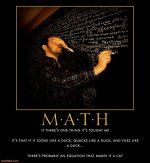I think the least understood is how the angle of attack and the speed of the cue stick affects the force applied to the CB.
I use angle of attack to describe the angle the cue stick center lines are in relation to where the cue impacts the CB and the table.
A true center ball impact is when the center lines of the cue stick is on the same planes as the CB's center lines. When the stroke is executed, the center lines of the cue stick remains on the same planes of the CB center lines.
You can have true center ball hit even when jacked up because the cue stick horizontal center line rotates at the CB center poin , but how the CB responds to the applied force is not the same as a true center ball hit with the cue stick level with the table when stroked or the cue impacts the CB at a angle not on the one of the CB's center lines.
Angle of attack is the angle at which the cue stick impacts the CB when one or both of the cue sticks center lines are not on the same center line planes as the CB's center lines or the table.
This is a rough 1st draft of something that's been in my head and the recent english threads brought it make in mind.....The dots are impact points, the arrows are cue sticks. Enjoy...
If you were to extend those arrows out just a bit, I believe your drawing would sync up quite nicely with something I wrote about 10 years ago. We were originally talking about the balance point of pool cues:
#####
my 2 cents
My experience has been that the balance point doesn't actually change much about the cue ball action produced. What it can change is the final orientation of the cue in relation to the cue ball, the table, our arm, and head. It's like trying to find the right pin in a pin cushion...
Think of yourself as a mobile -- you know, one of those art thingies with multiple parts on strings hanging from the ceiling. A cue is like added weight on one of the arms of a mobile. A pool player carries the cue around the table on the way to the next shot, sort of as a mobile. Depending on where that is on the cue, and how the cue is balanced, it can either be in harmony with the rest of the mobile and result is a level cue properly oriented to the cue ball, table, our arm, and head (IOW, optimally setup for a goodly stroke), or, it can end up out of harmony and result in a misaligned cue. If the cue is balanced in such a way -- say more weight up front or back -- in relation to how we carry the cue and the movement we use to get into shooting position -- it can subtly alter the cue's final orientation. Think of one of those tomato looking pin cushions -- pick a spot and start putting pins into it. Many pins later, the end result is much like the various strokes we use from day-to-day -- they all look like they're lined up on the same spot on the cue ball, but in fact, different cue balance points (to say nothing of different preshot routines) subtly alter the final orientation of our cue and stroke.
I think this relates to the observation about different balance points making it harder to hit stop shots and the player's ability to hit the cue ball dead center, as well as the mystery about how good players go through the cue ball differently -- it's the pin cushion thing. What we're all trying to do is find the right pin. Problem is, at any given time, most of us have about two dozen pins in our cushion

#####
Lou Figueroa

